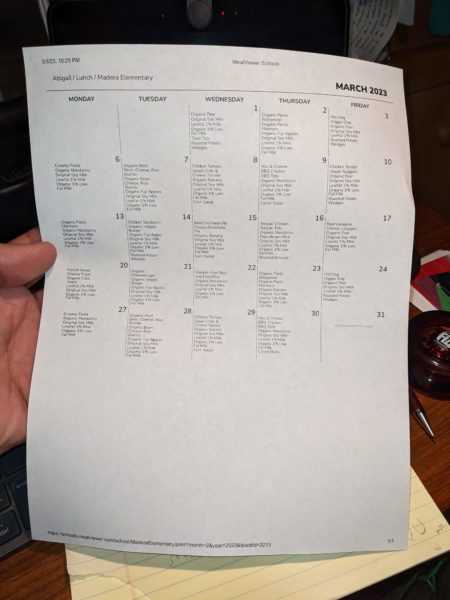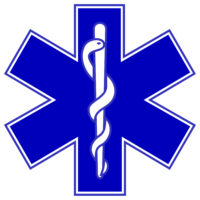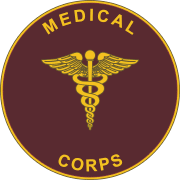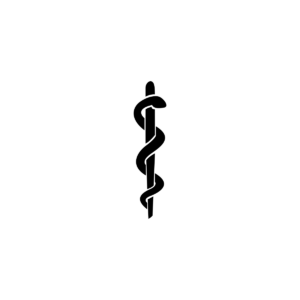Archive for the ‘Rants’ Category.
Actually Getting Rid of Daylight Savings Time
I’ve been railing on the idiocy of Daylight Savings Time on this blog for literally 20 years.
Now, the dream that actually helps dreamers sleep at night might actually come true! The Sunshine Protection Act has been moving it’s way through the hallowed halls of congress and might actually (mostly) get rid of daylight savings time forever in the US! Hurray and Huzzah! The “mostly” part is that we’d permanently be one hour off of the actual solar time. That’s moderately less idiotic than switching our clocks twice a year. I’ll take it. I’m glad to hear that politicians still find it necessary to meddle with the fabric of time itself.
Here’s a promotional poster for it: sunshine-protection-act-2019-one-pager
Write to your federal house representative in favor of the Sunshine Protection Act!
Here’s my letter to my house representative:
This may seem like a small issue but I beg of you to please say “yes” to the Sunshine Protection Act, (S623). It passed the Senate on March 15th, 2022 Get rid of Daylight Savings Time! That twice-a-year change screws me up for a week. Does it mess up your week? It messes up everyone in the country’s week! Get rid of it!
Update: read the comment below!
Prosodic Stress
I’ve always been bothered that English writing has no great way of describing prosodic stress. I only learned that term today but I’ve understood it for decades! What is “prosodic stress”? I’ll borrow from Wikipedia which has a nice definition and example:
I didn’t take the test yesterday. (Somebody else did.)
I didn’t take the test yesterday. (I did not take it.)
I didn’t take the test yesterday. (I did something else with it.)
I didn’t take the test yesterday. (I took one of several. or I didn’t take the specific test that would have been implied.)
I didn’t take the test yesterday. (I took something else.)
I didn’t take the test yesterday. (I took it some other day.)
 Sadly, italics and bold usually come off as gauche, similar to how red circles get overused in memes.
Sadly, italics and bold usually come off as gauche, similar to how red circles get overused in memes.
Thanks to Tom Scott’s Why Shakespeare Could Never Have Been French video for teaching me the term!
Are Toilet Seat Covers Effective?
Are toilet seat covers effective? Go ahead and google it, I’ll wait.
When used correctly, they don’t keep you dry nor do they keep any diseases away from you. Ok, so why do they exist? Who uses them? Really.
But they are in most public bathrooms. I don’t understand! Does the toilet seat cover industry have good lobbyists or something?
When I want a clean toilet seat, I wipe down the seat with the toilet paper. If it’s bad, I use another stall. Sometimes I use the soap and water with the toilet paper to clean and dry the seat. I mean, it’s right next to the toilet, and it’s in the name… “toilet paper.”
Sloppy Equifax
I wrote this letter to Equifax today:
I got an email from TrustedID Customer Service <no-reply@trustedid.com> today. In it there was a sure sign of a phishing attack, only it wasn’t.
It reads like so:Subject: New Credit Monitoring Alert…We’ve noticed a change on your credit report, and we encourage you to log in to your account to view details at www.trustedid.com.Notice that the text reads “www.trustedid.com” but the link behind it reads “http://click.e.equifax.com/?qs=b15633469f1…”Don’t do that shit. There is arguably only one key bit of protected information on the internet, domain names. Customers should only ever click on matched text and links. If you get customers used to clicking mismatched text and links, you get them used to being scammed.Please write back and tell me you’ll fix this type of error in your emails.Thank you,Lee Sonko
The Primaries Aren’t Elections
First, want something funny and completely related to the post below:
Now on to my rant…
The common narrative is that the Presidential Primaries are elections that determine for each party who will be put forward in the general election. This narrative is incorrect. Political parties are not governmental bodies and are not beholden to the election process. Case in point: Bernie Sanders was favored by Democratic party members but Hillary was put forth by the party. A lawsuit against the DNC was dismissed last week, partially because Bruce Spiva, representing the DNC, described how they could do whatever they want, regardless of what their members wanted. Here is a snippet from the Washington Post:
Bruce Spiva, representing the DNC, made the argument that would eventually carry the day… he explained how the DNC worked, Spiva made a hypothetical argument that the party wasn’t really bound by the votes cast in primaries or caucuses.
“The party has the freedom of association to decide how it’s gonna select its representatives to the convention and to the state party,” said Spiva. “Even to define what constitutes evenhandedness and impartiality really would already drag the court well into a political question and a question of how the party runs its own affairs. The party could have favored a candidate. I’ll put it that way.”
Now I remember why “politics” is a four letter word.
Caduceus vs. Rod of Asclepius
When you want an icon that refers to medicine, use the rod with one snake, called the Rod of Asclepius. For commerce (and some other things, see below) use the winged staff with two snakes, called the Caduceus. These two symbols have very different meanings!
The Rod of Asclepius (displayed to the left) is the symbol for the Greco-Roman god Asclepius, known for his connection with medicine. It is a rod with one snake. The symbol is used today to represent the medical profession. You can commonly find this symbol on ambulances and everywhere medical symbols or logos are needed.
The Caduceus (displayed to the right) is the symbol for the Greco-Roman god Hermes or Mercury. It is a staff with two snakes and wings. Hermes is known for being a messenger of the gods, protector of merchants, guide to the dead, shepherds, gamblers, liars, and thieves. The Caduceus is generally used today as a symbol of commerce.
Why is there confusion in the U.S.?
In 1902 the US Army Medical Corp chose the Caduceus as their insignia. Most scholars regard this as a flat-out mistake. The US Army writes that the Caduceus represents “the non-combatant status of military medicine on the battlefield”, which is to say they fully admit they are not using it as a medical symbol. The Encyclopedia Britannica notes, “Among the ancient Greeks and Romans [the Caduceus] became the badge of heralds and ambassadors, signifying their inviolability.” So maybe the US Army was thinking the symbol would convey a sense of “… Hey, hey, hey, don’t kill me, I’m just a messenger delivering the wounded to the hospital!” or some such. That is quite a stretch; I think somebody just used the wrong symbol. Today, military ambulances use the red cross and and civilian ambulances use the Star of Life, which prominently features, you guessed it, the Rod of Asclepius.
So why shouldn’t a medical provider use the Caduceus? Oh, let me count the ways! Being the symbol of Hermes, at best, it implies the medical professional is either selling or delivering something. The closest you’ll ever get to it being the right symbol is for a palliative care setting where medical professionals carefully “transport” those in their care into the afterlife. It goes downhill from there; it may imply the medical provider will kill you (Hermes is the guide to the dead!), feed you to the dogs (shepherds!), hock your jewelry (gamblers!), and tell your mom they haven’t seen you in a week (liars and thieves!). It is generally not a reassuring medical symbol. If you are a medical provider, please do not use the Caduceus!
- The Rod of Asclepius, a medical symbol
- The Caduceus, a commerce symbol
- The Star of Life, a medical symbol
- The US Army Medical Corps Insignia
- Rod of Asclepius 2018 redesign by the United Nations
Academic research on the subject is very clear. The Caduceus is not a medical symbol, the Rod of Asclepius is. 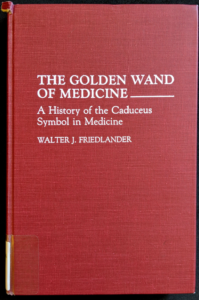 The best research can be found in the 1992 book The Golden Wand of Medicine a History of the Caduceus Symbol in Medicine by Walter Friedlander
The best research can be found in the 1992 book The Golden Wand of Medicine a History of the Caduceus Symbol in Medicine by Walter Friedlander
Dr. Friedlander spends 181 pages meticulously reviewing the history of the two symbols from their origins to the present day. It is very well researched, with lengthy bibliographies. He nails down with all the certainty that can be mustered by the best academician that the Caduceus is the wrong symbol to represent medicine. Read the final sentences of the book read (bold is mine):
It seems most likely that the caduceus became associated with medicine because of two errors: confusion of Traditional Hermes with other Hermes, and lack of recognizing or knowing the difference between two distinct serpentine objects, Traditional Hermes’ caduceus and Aesculapius’ staff. The result is that present day medicine, particularly in the United States, often shares the same symbol with merchants and commerce. Although, unfortunately, many lay people may think this is appropriate, it seems unlikely that most medical people, if they understood the underlying meaning of this object, would find it suitable. – page 158
Here are some scans of the first page and the concluding pages of The Golden Wand of Medicine.
There are a plethora of other resources I welcome you to explore. They all say the same thing. “Use the rod of Asclepius as the medical symbol”. Here’s a few articles from highly regarded sources to get you started:
- Finn, R., Orlans,D. A., Davenport, G. (1999). A much misunderstood caduceus and the case for an aesculapion. The Lancet, 353 (9168), 1978. http://dx.doi.org/10.1016/S0140-6736(05)77199-3
- Wilcox, R. A., & Whitham, E. M. (2003). The Symbol of Modern Medicine: Why One Snake Is More Than Two. Annals Of Internal Medicine, 138(8), 673. http://www.ncbi.nlm.nih.gov/pubmed/12693891
- Things you don’t learn in medical school: Caduceus http://www.ncbi.nlm.nih.gov/pmc/articles/PMC4439707/
- Wikipedia has a trove of well referenced info about the subject: Caduceus as a symbol of medicine, Caduceus, Rod of Asclepius, pictures of Ambulances, etc…
- Realizing the mistake, Monmouth University Nursing School removes the Caduceus from their logo in 2018
- Encyclopedia Britannica entries for Caduceus, Hermes, the Rod of Asclepius, and Asclepius.
————————————————–
Here is the full text from the US Army Medical Department Office of Medical History Frequently Asked Questions page, retrieved 10-31-20: (bold is mine)
Why does the Army Medical Department use the Caduceus, which represents the Greek god Hermes and the Roman god Mercury, instead of the Staff of Asclepius, the Greek god of healing?
The Army Medical Department uses both the Caduceus (Mercury’s/Hermes’ Staff) and the Staff of Asclepius as symbols for the Army Medical Department (AMEDD). The Staff of Asclepius, or Aesculapius, symbolizes the medical mission of the AMEDD, and is included on the AMEDD Regimental Crest (the staff with one snake entwined around it). The Caduceus, two snakes around a winged staff, symbolizes the non-combatant role of the AMEDD. The Caduceus was first used on enlisted men’s uniforms in 1851, over a decade before the establishment of the Red Cross as a symbol of non-combatants. In 1902 the Caduceus was chosen to replace the Maltese Cross insignia on Medical Corps officers’ collars. In 1907, the Army Nurse Corps – the only other officer corps in the AMEDD at that time – began wearing a Caduceus with the letters ANC superimposed over it. Since that time, all new officer corps have been represented by a Caduceus specific to their corps, worn on the collars of their officers. After the First World War, many medical professionals left the army and returned to civilian practice. When they did, they took with them the Caducei they had worn proudly as members of the Army Medical Department. Over time, the Caduceus became associated with medicine in America, even in medical practices that had no association with the Army. Originally, though, the Caduceus did not stand for medicine, but represented the non-combatant status of military medicine on the battlefield.
————————————————–
Notes:
“Asclepius” is also spelled Asclepios or (Latin) Aesculapius
The Rod of Asclepius image above was created by David Khai, distributed by The Noun Project. The fine folks at the Noun Project were a great help when I brought this issue to them, fixing hundreds of their catalog listings appropriately! Thank you!
Another Plea for Legible Flight Reservations
Another Plea for Legible Flight Reservations
Grrrr!
We’ve been at this whole commercial flight thing for about a hundred years. You would think that the airlines would be able to create a simple, clear flight plan for me. EVERY trip I have made for the last 20 years I have had to translate their gobbly-gook flight reservation into something legible. The relevant data is always the same. Could someone in the airline industry please recognize this? Give me a calendar item that I can copy and paste into my life!
Here is what I put in my calendar. Short. Readable. Useful.
Flight Ref: XXXX
Monday November 21st
depart SFO at 10:35am on AA flight 556
arrive Chicago ORD at 4:55pm
depart Chicago ORD 8:30pm on AA flight 4308
arrive Nashville 10:00pmFriday November 25th
depart Nashville 4:30pm on AA flight 661
arrive Dallas DFW at 6:40pm
depart Dallas DFW at 9:20pm on AA flight 1575
arrive SFO at 11:05pm
and here is what American Airlines sent me. It is freaking impossible to read. Sure it contains all the relevant data but I challenge you to understand my flight info in less than 5 minutes!
It doesn’t need to be like this. Make it simple. Make it say what it needs to say. Then put the nitty gritty details at the bottom or something. Bonus points awarded if they put a “Add to Google Calendar” icon next to the reservation so I don’t even have to copy-paste. But hey…
I originally mentioned this in 2011 and it burns my buns every time I fly that flight reservations are still universally impossible to read. I use parts of this blog post as a template before I fly.
Wisdom Teeth
Short form: 2/3 of wisdom teeth removals are unnecessary and dentists don’t really want you to know.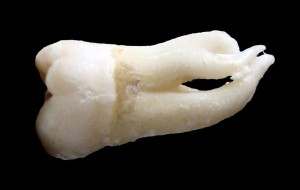
In about 1999 I had a wisdom tooth removed because the gum had gotten infected, inflamed, and painful. The dentist suggested I get all of my wisdom teeth out “because it would be better in the long run.” I declined, just getting the one tooth removed.
In about 2003 I had a new dentist after moving. I remember the intake form had this on it:
Do you still have your wisdom teeth?
Yes | No
If so, why?
The answer I wrote was “because I use my teeth to chew my food“. Of course, the intake form question lead to a discussion with the dentist. I had this crazy belief that nature wouldn’t create a system where every human was better off if they had four serious dental surgeries as a matter of course.
I was incensed. This question, delivered by a board certified professional dentist practically stated that it was wrong of me to have wisdom teeth. The follow-up is of course, “…and you know, we can fix that problem for you.” It’s like bringing your car in for an oil change and having the mechanic tell you that your confabulator needs realigning, and if you don’t get it done soon, well, who knows what will happen! I’m allergic to professionals using Fear, uncertainty, and doubt on me. I didn’t go back. I thought about blogging about it back then but who has time for that junk?
Well, I just came across this article more-or-less confirming my suspicions. It says about 2/3 of wisdom teeth shouldn’t be removed. But don’t believe the article, believe the links the author shows us…
- The Prophylactic Extraction of Third Molars: A Public Health Hazard, in the American Journal of Public Health. 2007 September; 97(9): 1554—1559. doi: 10.2105/AJPH.2006.100271
- The British National Health Service saying, “Your wisdom teeth don’t usually need to be removed if they’re impacted but aren’t causing any problems. This is because there’s no proven benefit of doing this and it carries the risk of complications.”
And here is a VERY curious article I found in the Cochrane database (Cochrane is awesome, it’s like the Consumer Reports of research, they look for and help create systematic review research because it is so much better than individual studies).
- Surgical removal versus retention for the management of asymptomatic impacted wisdom teeth. – In brief, they couldn’t find any good research on whether it was better to leave wisdom teeth in or take them out preemptively. Something is very fishy there!
PS, Great thanks to the folks at The Daily Digg for putting the original article in my inbox, with the title of Wisdom Tooth Removal Is A Racket. The Daily Digg is one of my major sources of curated news right now. They practically hide the link to join their mailing list so… sign up here.
Chicco Keyfit 30 Car Seat Advertising is Intentionally Deceptive
Advertising for the Chicco Keyfit 30 Car Seat is intentionally deceptive.
 The Chicco website says that it holds a baby “from 4-30 lbs” but they never mention that there is a very important height restriction. This is a dangerous and deceptive lie by omission. (See the Chicco website) (local archive). But the manual is very clear that it supports a baby “4-30 lbs, 30 inches or less.”
The Chicco website says that it holds a baby “from 4-30 lbs” but they never mention that there is a very important height restriction. This is a dangerous and deceptive lie by omission. (See the Chicco website) (local archive). But the manual is very clear that it supports a baby “4-30 lbs, 30 inches or less.”

You might be thinking, “Yeah, whatever, that is a small matter.” No, it isn’t.
The average baby outgrows the car seat by weight when they turn 30 months (2 1/2 years) old. But the average baby outgrows the car seat by height at 12 months old! (see the CDC height and weight tables) Our baby was 30″ tall at 9 1/2 months!
 The manual dictates that the product lasts 60% less than its marketing claims. That is deceptive advertising. Imagine buying a car that had a 10 year, 40,000 mile warranty! Would you feel cheated?
The manual dictates that the product lasts 60% less than its marketing claims. That is deceptive advertising. Imagine buying a car that had a 10 year, 40,000 mile warranty! Would you feel cheated?
The Amazon ad doesn’t mention this height restriction either (local archive).
We’ve had our Chicco Keyfit 30 Car Seat for a few months now and it has performed well. But our daughter outgrew it more than a year and a half sooner than we were led to believe by Chicco.
It is a fine product, they don’t need to stoop to this deception. This deception is dangerous for children because if you were to only read the marketing information, you might use this seat long after it was safe to do so.
